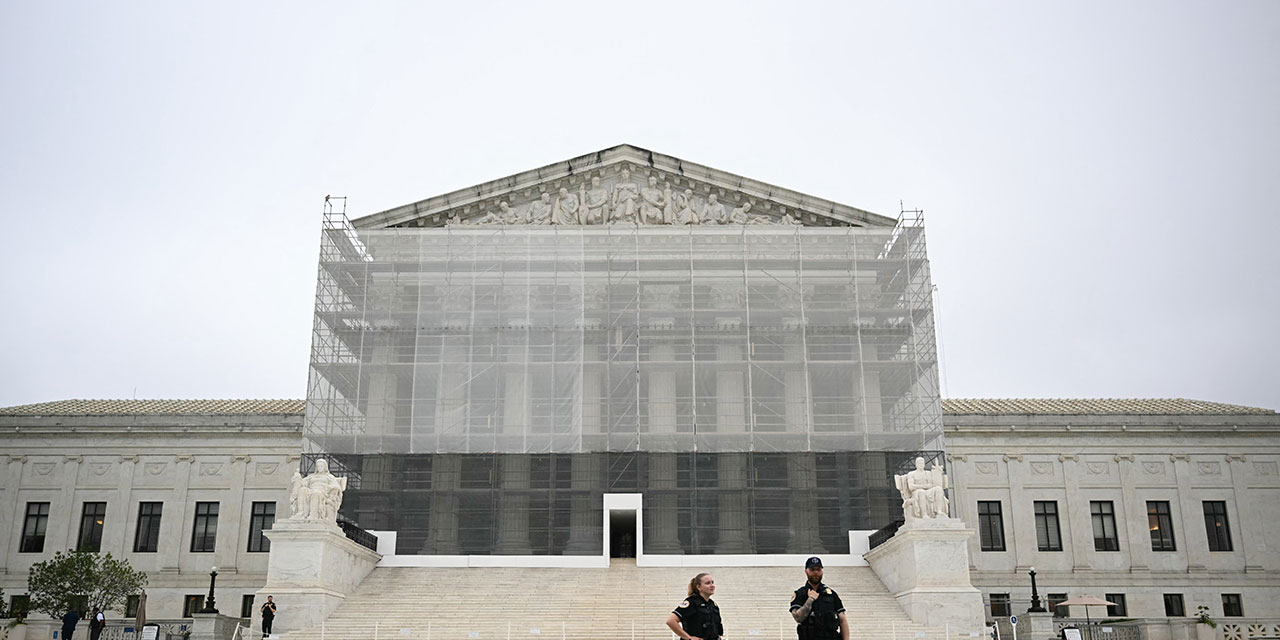
While the Supreme Court, which ended its 2024–2025 term last week, has dominated headlines, the term itself was surprisingly low-key. As usual, the justices reached consensus far more often than pundits would have you believe. It was also a strong term for the Manhattan Institute’s amicus brief program, which I have the honor of running.
The biggest decision—United States v. Skrmetti, which upheld a state law banning gender-related medical treatments for minors—was certainly significant. But much of the media attention focused on procedural battles over executive orders.
Finally, a reason to check your email.
Sign up for our free newsletter today.
Even the heavily discussed Trump v. CASA, said to curtail “universal injunctions” by district courts, is less sweeping than advertised. The majority granted relief “only to the extent that the injunctions are broader than necessary to provide complete relief to each plaintiff with standing to sue.” That leaves open the question of whether nationwide relief remains available in birthright citizenship lawsuits, especially since many states are plaintiffs and people move between them. The challengers have already filed a class action—another potential path to nationwide relief that the Court left intact.
The other headline cases—on age verification for porn sites and parental opt-outs from gender-identity and sexuality instruction in public schools—wouldn’t have made the “greatest hits” list of recent terms. After a steady run of major constitutional rulings on abortion, affirmative action, guns, and health care, this term felt underwhelming by comparison.
But even if the so-called blockbusters didn’t match the drama of past years, hasn’t judicial polarization accelerated, with conservatives and liberals locked in constant, high-stakes conflict? Not so.
Of the Court’s 56 signed opinions in argued cases—not counting the per curiam TikTok decision or emergency applications for stays of injunctions decided on the papers—half were either unanimous or 8–1. Only six cases split 6–3 along ideological lines, with the Democratic appointees in dissent. Two more were 5–4, with the liberal justices joined by a single Republican appointee (Neil Gorsuch in one, Amy Coney Barrett in the other). And in ten cases, three or four Republican appointees dissented, highlighting internal disagreements among conservatives rather than simple partisan divides.
As for advocates of the “3–3–3 Court” theory—with Justices Sonia Sotomayor, Elena Kagan, and Ketanji Brown Jackson on the left; Clarence Thomas, Samuel Alito, and Gorsuch on the right; and John Roberts, Brett Kavanaugh, and Barrett in the middle—it’s only partly borne out by the numbers. The middle bloc was in the majority more than any other justices, with Roberts leading at 95 percent. But there were only four cases in which the conservative trio dissented on its own. This is still a conservative Court, but one shaped by the unpredictability of its docket and marked by considerable jurisprudential fluidity.
Fittingly, the conservatives sided with the Manhattan Institute in all six cases where we filed amicus briefs; the progressives in none; and the moderates in either three or four, depending on how you count the 4–4 deadlock in the Oklahoma charter school case. Here’s a breakdown of how MI fared, with links to our briefs and background on each case:
Winning side (3): United States v. Skrmetti; Mahmoud v. Taylor;Free Speech Coalition v. Paxton.
Losing side (2): FCC v. Consumers Research,Kennedy v. Braidwood Management
Tied (1): Oklahoma Statewide Charter School Board v. Drummond
In Skrmetti, the Supreme Court affirmed what was already evident: Tennessee’s law restricting puberty blockers and cross-sex hormones is based on age and medical condition, not sex or gender identity. Legally, classifications based on those factors aren’t subject to “heightened scrutiny,” so the law doesn’t violate the Fourteenth Amendment’s Equal Protection Clause. More broadly, as MI’s brief explained, neither the scientific evidence nor leading global health authorities support the safety or efficacy of these treatments for youth gender dysphoria. It was, in short, a good day for science and reason.
In Mahmoud, it’s a relief—but no surprise—that the Court rejected Montgomery County’s cynical refusal to let parents opt out of sensitive, age-inappropriate material related to sexuality, which the school board euphemistically labeled “LGBTQ+ inclusive.” The policy was a national outlier, and a recent one. Until 2023, opt-outs were allowed, but the board eliminated them after too many parents exercised the option, an obvious signal that the curriculum warranted reexamination.
In Free Speech Coalition, the Court notably rejected the arguments of both the porn industry and the state of Texas on the technical question of which level of judicial scrutiny applies. It held that “intermediate” scrutiny is appropriate—and then correctly upheld Texas’s law, finding that it imposes only a minimal burden on adult speech. MI’s brief supported this view, explaining how modern age-verification technologies can protect privacy at low cost. By offering solutions that are affordable, privacy-preserving, user-friendly, and commercially reasonable, this form of age verification respects adults’ free-speech rights, while helping shield minors from harmful content.
In Consumers Research, the Court rejected the argument that the FCC’s Universal Service Fund amounts to an unconstitutional delegation of Congress’s taxing power to the executive branch, which then handed it off to a private entity. Justice Gorsuch’s 38-page dissent had the better of the argument, laying out how the FCC effectively taxes all telecom consumers according to principles it invented to fund a public-welfare program of its own design.
As my colleague Jim Copland put it, “The discretion afforded the FCC is a far cry from the carefully delineated ‘intelligible principles’ the Supreme Court upheld in J.W. Hampton [the leading case in this area, from 1928]. If the decision has a saving grace, however, it is this: all nine justices appear to agree that the nondelegation doctrine continues to have relevance, and all nine would hold Congress to at least the Hampton standard.” “Nondelegation” looms large in the Trump tariff cases, so these arguments are to be continued.
In Braidwood Management, it’s disappointing that the majority failed to recognize the flaws in how the HHS preventive-services task force is appointed. The ruling only further entrenches a bureaucracy that increasingly sets the rules governing our daily lives.
In Drummond, it’s unfortunate that the Supreme Court couldn’t correct the Oklahoma Supreme Court’s error in treating charter schools run by religious organizations differently from other schools. In an era of expanding educational opportunity, states shouldn’t be able to reject charter-school applications solely because of a sponsor’s religious identity. It’s a shame Justice Barrett recused herself, but the outcome makes it all the more urgent to advance school-choice legislation nationwide.
Finally, in Trump v. CASA, a case in which MI did not file a brief, the Court wisely reined in the use of universal injunctions, which have proliferated in recent years. While it’s not ideal to lack uniform national rules in some areas—and to have judicially created exemptions apply only to those who sue—the ordinary appellate process can accommodate the temporary legal unevenness that results. The Court is right: it distorts our constitutional system to let a single district judge block national policy for everyone.
As Justice Alito notes, many of these legal battles will now shift to questions of class certification and third-party standing, each with its own set of jurisprudential complexities. The most effective solution may be for Congress to step in and establish clearer procedures for challenging nationwide policy changes.
Now we look to next term, which already has some exciting cases. In Chiles v. Salazar (in which MI filed earlier this month), the Court will consider whether a law that censors conversations between counselors and their clients—based on viewpoints about sexual orientation and gender identity—regulates conduct or violates the Free Speech Clause. Bost v. Illinois State Board of Elections asks whether federal candidates have standing to challenge state time, place, and manner regulations governing federal elections.
In Case v. Montana, the Court returns to the Fourth Amendment for the first time in a while, asking whether police can enter a home without a search warrant based on less than probable cause that an emergency is occurring. And in First Choice Women’s Resource Center v. Platkin (in which MI filed a brief supporting the cert. petition), the Court will determine whether a group of faith-based pregnancy centers can go to federal court to challenge a state investigatory subpoena—implicating their First Amendment rights—or whether they have to go through the state court system.
But there’ll be time enough to dive into those cases, starting with MI’s annual preview event, this year to be held on the first Monday in October, when the new term begins. For now, we have the summer to reflect on what the justices have delivered.
Photo by MANDEL NGAN/AFP via Getty Images
Source link
















